
 |
CD-COPS/ DVD-Cops for NETWORKS |
Manual for CD-ROM/ DVD-ROM Publishers and Developers
CUSTOMER INSTALLATION, CD-COPS FOR NETWORKS
Server Installation: *
Client Installation: *
Customer Administration of CD-Cops for Networks *
SUPPORT TOOLS FOR CD-ROM PUBLISHERS
Upgrades *
Changing Network Parameters with MAKECODE *
Solving an Acute Problem with CDRESCUE *
Log Files *
This manual is intended for CD-ROM publishers who have protected their applications with the Network Version of CD-Cops and who plan to carry out their own end-user support.
As a rule, a network application will be installed in two stages:
The Server Installation will usually be carried out by the network administrator, while the Client Installations will usually be carried out by the individual end-users on their own workstations.
The actual installation procedure will vary widely from publisher to publisher. It is assumed that the person in charge of support is familiar with his own product and its normal network installation procedure.
CUSTOMER INSTALLATION, CD-COPS FOR NETWORKS
Hardware/software required to carry out server installation:
A local CD-ROM drive is required for installation so that CD-Cops (the copy protection program) can verify that an original CD-ROM is being used. The end-user inserts the original CD-ROM in the local CD-ROM drive and follows the installation instructions for the application in question.
During installation, the end-user is asked to supply two different codes:
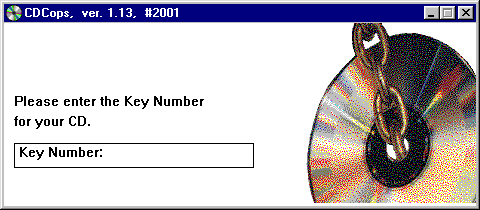
- Maximum number of simultaneous users.
- Maximum number of specified (by name) users
Later in the installation, this second dialog box will be activated.
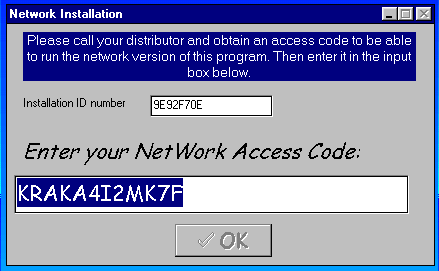
As shown above, an Installation ID Number is displayed. This number is reported to the publisher who then supplies the Network Access Code that is to be entered in the lower input field. It is this code that specifies the type and number of licenses that have been purchased.
When the Server Installation is complete, the CD-ROM can be inserted into a common network drive or jukebox.
The following information is necessary to perform a client installation:
With this data in hand, each client runs SETUP and follows the step-by-step instructions. In some cases, the network adminstrator may choose to carry out this installation himself.
Customer Administration of CD-Cops for Networks
Two programs for customer administration of the CD-Cops protected application are delivered as part of the CD-Cops Network package. During the server installation, these two utilities are to be installed on the system administrator's machine. The programmer responsible for creating the installation script should therefore copy these utilities to the hard disk and create icons pointing to them.
The NetInst Program

In order to change the network configuration, e.g. to increase the number of users, the network adminstrator runs NetInst. In many cases, the icon pointing to NetInst will be called Registration Control. See Upgrades below.
To carry out an upgrade, the administrator must have the original CD-ROM in his local drive, just as he did during the original installation. When NetInst is run, the Installation ID is displayed, as well as the current access code. A new code, which will modify the network parameters, can now be retrieved from the publisher and entered.
The NetStat Program
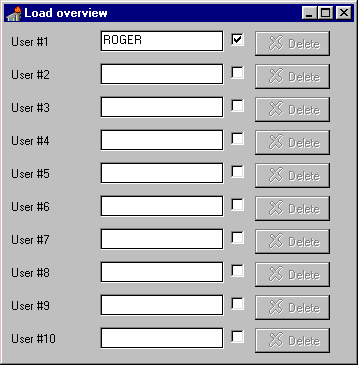
The Status utility is designed to show the network status for the protected application. Its function differs for different network parameters:
For Maximum number of named users:
As each users logs on, his name will be shown in
the Load overview window. As long a user is active, the
checkbox will be marked. When a user closes the application, the Delete
button will be activated and the checkmark will disappear. If a
user is to be deleted, this must be done while he is not running
the applications.
For Maximum number of users:
As users log on and off, the check boxes will be
activated and de-activated. If the number of licenses is
exceeded, the last user will be informed that no more licenses
are avialable. Neither the name field nor the delete button are
relevant for this type of protection, since there is no control
over who uses the application.
SUPPORT TOOLS FOR CD-ROM PUBLISHERS
In order to change the network configuration, e.g. increase the number of users, the network administrator should run the Registration Control (NetInst). icon that was created during the original server installation.
To carry out the upgrade, the customer must have the original CD-ROM in his local drive, just as he did when making the installation. When Registration Control starts up, the Installation ID and the current network access code are displayed. A new code can now be obtained from the publisher. This code could for example change the number of users, or change the network to a named instead of unnamed type.
Changing Network Parameters with MAKECODE
The main publisher tool is a code generator which creates codes for the network configuration. Among other things, this code determines the maximum number of simultaneous users.
The CD-title must be selected and the Installation ID reported
from the system administrator must be entered.
User count and end-user company name must be filled in, and the
resulting Access Code is reported to the administrator via
telephone or otherwise.
The various fields in the MAKECODE program are described at the
bottom of the window. These settings can be pre-configured for
each CD-title.
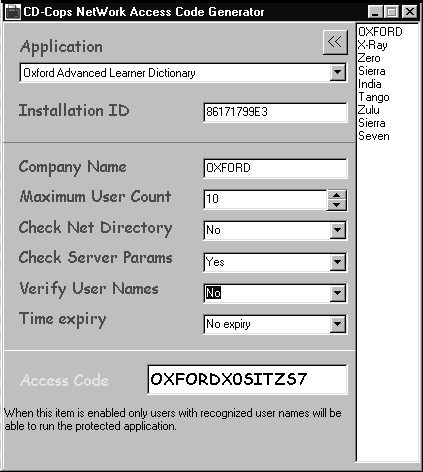
Solving an Acute Problem with CDRESCUE
This program generates a rescue code for end-users who cannot get the CD to function. In rare cases where an original CD is not recognized, a message is displayed informing the user that the CD has been rejected, and at the same time, a 4-digit machine code is indicated. A legitimate end-user can now call the publisher. Using this machine code as an input to CDRESCUE, the publisher generates a machine-specific code that will enable the customer to proceed with the installation.
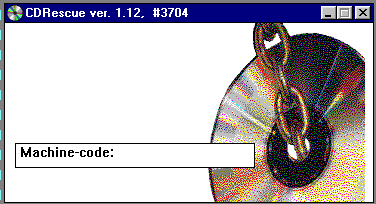
When a problem requiring the use of CdRescue occurs on an end-user machine, a log file CDCOPS.LOG is generated in the root directory (usually C:\). If possible, this log file should be retrieved from a customer who is having problems and sent to the CD-Cops support crew.
This page edited : 21 jul 1999 16:18:02
Link
Data Security A/S, Vesterbrogade 51, 1620 Copenhagen V, Denmark
Phone +45 33 23 23 50, Fax +45 33 23 84 48
This page is part of our old site and is no longer maintained. Click here to go to our new site
Topics: software security, software piracy, anti-piracy, software metering, license management, license control, software protection, CD-ROM protection, Cd-Cops, CopyLock,WinCops, DialCops, DialProg, copy protection, copy discouragement, illegal copying, illegal distribution, DVD-Cops, WebCops, CdCops, demo protection, machine installation, Crypto, data encryption, load mode, reboot mode, key diskette, keydisk